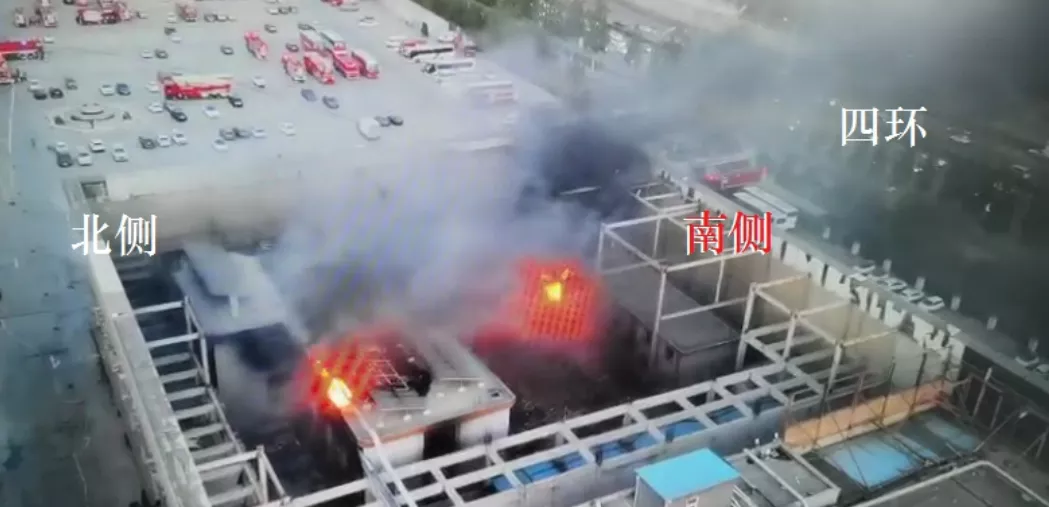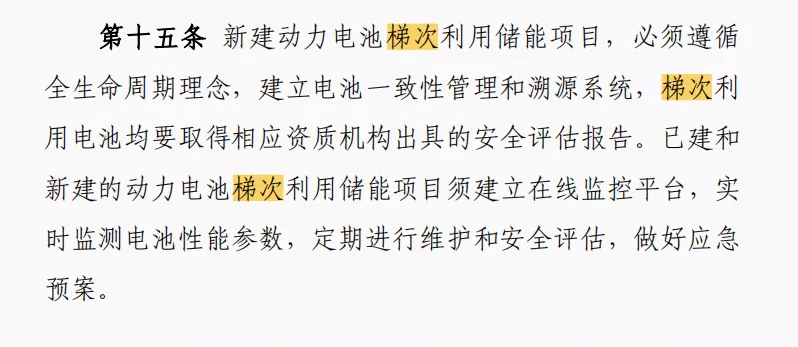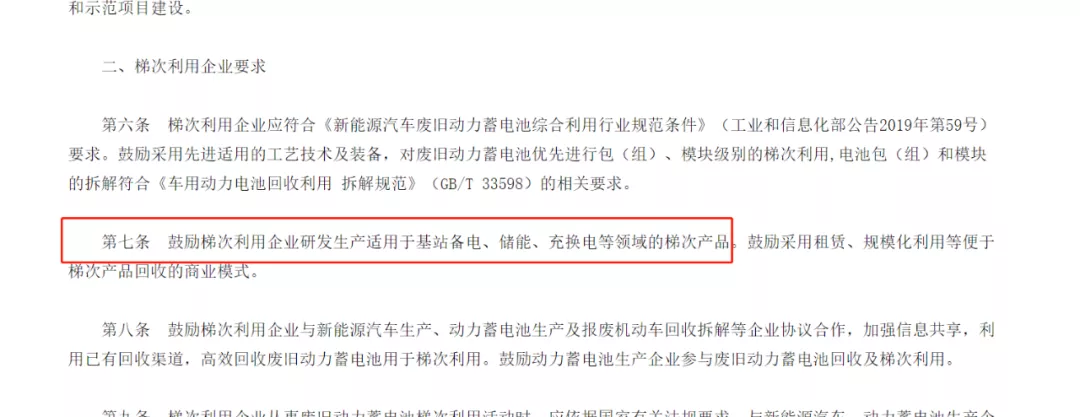Author: Wang Lingfang
After 7 months, the investigation results of the explosion at the Beijing Dahongmen Energy Storage Power Station on April 16th have finally been released, which was caused by a short circuit in the lithium iron phosphate battery.
On November 22nd, the investigation report on the fire and explosion accident at the Energy Storage Power Station in Fengtai District, Beijing was officially released. The investigation team determined that the direct cause of the fire in the South Building was a short circuit in the lithium iron phosphate battery in the West Battery Room, which caused the battery to lose control and catch fire.
The direct cause of the explosion in the North Building was the short circuit in a single lithium iron phosphate battery in the South Building Battery Room, which caused the battery and battery module to lose control and spread the fire. The flammable and explosive mixture produced by the accident entered the Energy Storage Room in the North Building through the cable trench, mixed with the air and formed explosive gas, which exploded on encountering electrical sparks.
The accident resulted in 1 death, 2 deaths of firefighters, 1 injured firefighter, and a direct property loss of 16.6081 million yuan.
The accident has been identified as a liability accident, and the investigation team recommended that relevant responsible persons should be held accountable.
As the ownership of the relevant facilities of the accident belongs to Sinopec Oil and Gas Company, the legal representative of Sinopec Oil and Gas Company, Liu Bo, the logistics director Shuai Changsheng, and the operation and maintenance staff Chen Yuanzhong were arrested and investigated for criminal responsibility. The responsible persons of the Street Working Committee, the Fengtai District Development and Reform Commission, and other related departments were given administrative sanctions.
Investigation Conclusion
In order to identify the results, the investigation team used various forces to cooperate and analyzed it through simulation and other methods.
After analyzing the rectangular battery that was first faulty in the South Building, the Vehicle and Transportation College of Tsinghua University’s Battery Safety Laboratory determined that the out-of-control battery would produce projectiles, mainly including dimethyl carbonate vapor and hydrogen, methane, carbon monoxide, carbon dioxide, etc.

Through smoke simulation by the Institute of Building Fire Research of the China Academy of Building Research, the smoke mixture (including insufficiently burned lithium iron phosphate battery thermal runaway jet products) produced at the scene after the South Building caught fire can enter the cable trench indoors in the North Building. The concentration of flammable and explosive gas before the explosion in the North Building was about 31%, with a total of not less than 280 cubic meters.
The Simulation Laboratory of Explosives Science and Technology at Beijing Institute of Technology simulated the explosion process and determined that when the flammable and explosive mixture (hydrogen, methane, carbon monoxide, dimethyl carbonate, etc.) inside the North Building reached 200 cubic meters and encountered an ignition source in the Energy Storage Room, the simulated damage scene matches the accident scene, with an explosive equivalent of 26 kilograms of TNT.According to the analysis of the investigation team based on on-site videos, on-site inspections, and physical evidence identification, the explosion in the North Building was consistent with the characteristics of a volumetric explosion, and was determined to be caused by a gas explosion. The material responsible for the explosion was a flammable and explosive component from the lithium iron phosphate battery thermal runaway jet product in the South Building, mixed with air to form an explosive gas. The ignition point was determined to be an electrical spark generated in the energy storage room, ruling out factors such as human activity and battery ignition.
The smoke containing the lithium iron phosphate battery thermal runaway jet product spread from the outdoor underground cable trench to the North Building, entered the high-voltage (nominal 720 volts) DC battery system, and caused the relay (located at the bottom of the battery cabinet) to spark. The public security organs conducted on-site inspections and inquiry analysis, ruling out intentional criminal suspicion.
However, according to relevant national laws and regulations, the investigation team determined that this was a responsibility accident. In addition to the direct cause, there were two indirect causes:
Firstly, the safety main responsibility of the related enterprise was not implemented, and there were unrecorded construction problems during the construction process. The project continued to operate despite issues such as battery leakage and heating and smoking that had not been completely resolved, and the outdoor underground cable trench between the South and North Buildings was not effectively separated and sealed. The emergency response plan was not formulated according to the actual risks of the site.
Secondly, the relevant units did not conduct thorough safety supervision and inspection work, and research on the high-quality development of new energy projects that ensured safety was inadequate. The safety hazards investigation was not comprehensive and thorough, and safety risks in the construction, operation, and maintenance processes of the project were ignored or managed improperly. Therefore, responsibility for the accident was assigned to the relevant personnel, and Liu Bo, the legal representative of Fuweis Oil and Gas Company, Shuai Changsheng, logistics director of Fuweis Oil and Gas Company, and Chen Yuanzhong, an operations and maintenance staff member were all held criminally responsible and approved for arrest. The officials responsible for the street working committee and the development and reform commission of Fengtai District were also given administrative sanctions.
In addition, according to the investigation by the Fengtai District Development and Reform Commission, the existing energy storage project involved in the accident was not recorded as a pre-existing project. The Development and Reform Department ordered Fuweis Oil and Gas Company to rectify the project and make legal and regulatory corrections.
Fuweis Oil and Gas Company is held by Hefei Guoxuan High-tech Power Energy Co., Ltd, Liu Bo (personal), Beijing Fuweis Investment Management Center (Liu Bo’s controlling stake), and other individuals, who hold approximately 40%, 33%, 24%, and 3% of the shares, respectively. In August 2018, Fuweis Oil and Gas Company partnered with HeFEI XunYi Investment Management Co., Ltd. to establish Beijing Guoxuan Fuweis Light Storage and Charging Technology Co., Ltd, which holds part of the project’s assets, with Liu Bo being the legal representative, but there is actually no organizational structure or personnel.
The batteries used in the project were all produced by Hefei Guoxuan High-tech Power Energy Co. and provided with battery testing materials. It is understood that this project is likely a secondary-use energy storage project.
Government’s Changing Attitude Towards Secondary Use Batteries
After this incident, the government has become hesitant about the application of secondary use batteries in the energy storage field.On the one hand, with the goal of “carbon peaking and carbon neutrality”, China’s new energy installation has been rapidly increasing, making the demand for energy storage stronger. In 2020, many regions have issued policies to encourage and support the configuration of energy storage for new energy, but almost no province has made mandatory requirements for configuration.
Since the beginning of this year, more than 20 provinces and cities have proposed renewable energy to configure energy storage requirements. Among them, some are mandatory and some are encouraged. For example, Hunan, Shandong, and Hubei are mandatory, while Shanxi and Gansu are recommended. The configuration ratio is between 10% and 20%.
The demand for energy storage is becoming stronger.
On the other hand, in June of this year, the National Energy Administration’s “New Energy Storage Project Management Norm (Trial) (Consultation Draft)” explicitly stated that before the key breakthroughs are made in battery consistency management technology and power battery performance monitoring and evaluation system is established, large-scale power battery ladder utilization energy storage projects should not be newly built.
However, in the formal version released in September, the National Energy Administration did not prohibit the use of ladder batteries in energy storage. Only requirements were made for the supervision, maintenance, and utilization of ladder batteries.

Prior to this, in August, the Ministry of Industry and Information Technology and other five departments issued the “Management Measures for the Integrated Utilization of Waste Power Batteries in New Energy Vehicles” (hereinafter referred to as the “Management Measures”), which explicitly encourages the use of ladder batteries in backup power, energy storage, and charging and replacement fields.

However, the “Management Measures” also have specific requirements for ladder enterprises, responsibility, and products.
On the enterprise side, battery pack (group) and module disassembly must comply with the relevant requirements of the “Recycling and Disassembly Specifications for Vehicle Power Batteries” (GB/T 33598) in accordance with the requirements of the “Conditions for Comprehensive Utilization of Waste Power Batteries for New Energy Vehicles” (MIIT Announcement No. 59 of 2019).
On the responsibility side, the enterprise should clarify the responsibility relationship.
Article 9: When an enterprise engaged in the waste power battery ladder utilization activity, it should coordinate with new energy vehicles and power battery production enterprises to resolve issues related to intellectual property rights and product safety responsibilities in accordance with relevant national regulations.
Article 11: Ladder utilization enterprises should standardize ladder utilization, have a ladder product quality management system and necessary inspection equipment and facilities, pass the quality management system certification, and the ladder product inspection rules and methods used meet relevant standard requirements. It is responsible for the warranty and after-sales service of the ladder products produced and sold by the company.## Product Design
In terms of products, the design of tiered products should comprehensively consider factors such as electrical insulation, flame retardance, heat management, and battery management to ensure the reliability of tiered products. The structure and connection methods should be easy to maintain, disassemble and dismantle, facilitating their dismantling, disassembly, and recycling after being scrapped.
Government’s Attitude
Overall, the government encourages the application of tiered batteries, while also setting relatively high requirements for supervision. The severe handling of this incident has sounded the alarm for the application of tiered batteries and safety management cannot be taken lightly.
This article is a translation by ChatGPT of a Chinese report from 42HOW. If you have any questions about it, please email bd@42how.com.